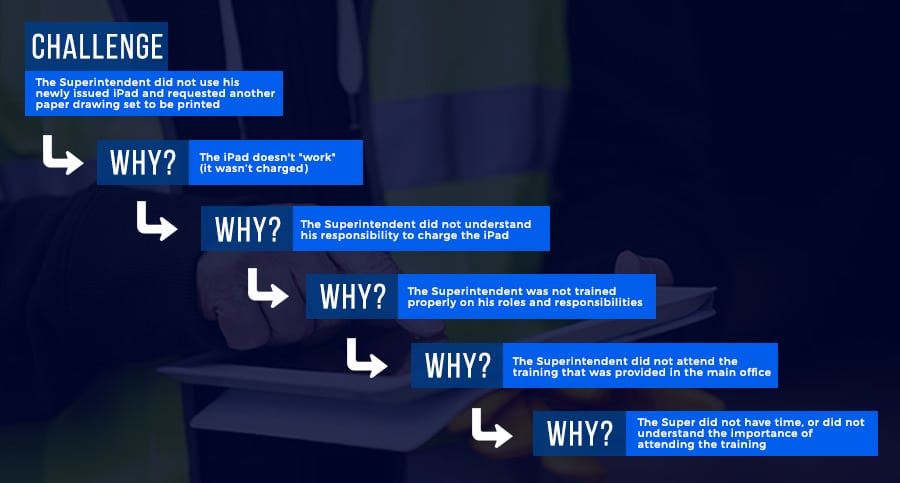In part 1 of this series, Do You Trust Your Lean Team Members, I discussed internal vs external trust. Once both sides are established and organizations understand their interconnectedness, teams need to go down that rabbit hole to differentiate symptoms of ‘shared pain’ from root causes. A helpful tool is the Five Whys Methodology.
It is no secret that there is no long-term fix when treating symptoms of a disease. We need to look deeper to find the root cause while being open at considering diverse opinions and viewpoints so that we can make the best informed decisions to resolve it.
The Five Whys Methodology
One simple yet effective methodology for identifying the root cause of a trust breakdown is a Lean tool called the Five Whys Methodology. It digs down five levels into the root cause that led to the pain in the first place.
Warning:
Participants using this tool may not always like the direction of the analysis and will attempt to steer it on another path. Begin by explaining to your team members that the room is a safe space for analysis and learning, free from blame and judgement, which requires a growth mindset.
Let’s look at an example:
A superintendent requests another paper drawing set to be printed because “the iPad is not charged.”
Looking at the illustration, you can see that it is not the iPad and a technology challenge that is the root cause of his request.
As we break down each level of the root causes, some important themes emerge.
Image: Autodesk BIM 360
Level 1: Communication breakdown
The iPad doesn’t work (it wasn’t charged).
Without jumping to conclusions, both parties can agree there was a communication breakdown. If taken at the surface level without further inspection into what “it’s broken” actually meant, the core issue would never have been resolved.
Level 2: Misaligned expectation
One level further, after finding that “broken” was simply “not charged,” a different issue is unearthed. There was a misaligned expectation. The superintendent did not understand his responsibility to charge the iPad.
Level 3: Misunderstood contract/priority
The superintendent was not trained properly on his roles and responsibilities. At this level comes a breakdown in perceived priority. Both parties are likely to hold at least some blame for the misunderstanding. Did the Superintendent disregard their responsibility because they didn’t know? Or because they didn’t care to know?
Level 4: Adversarial incentive structure
Further down the root cause rabbit hole, it becomes apparent that the superintendent did not attend the offered training. Why? Maybe there was a lack of peer group support (none of the other Superintendents are using iPads). Or, maybe the iPad training that was provided in the main office was not convenient for the Superintendent working on a project 75 miles away.
Either way, it gave the super a justified excuse to disregard their responsibility
Level 5: Culture of risk avoidance, not management
Finally, we have to ask whether the Superintendent did not have the time or whether he did not understand the importance of attending the training. At this step, we find out that the Superintendent was in the middle of the most challenging part of a high-stakes, fast-track project. If we look at the situation from a bird’s perspective, he was focused on the right priorities. But at what cost? Of course high-risk, time-sensitive situations come up in construction. However, if we’re too focused on doing things the way we always did them, how will we ever make time to improve?
In summary
The Five Whys Methodology is a great mental model to help organizations and Lean teams unearth the root causes of trust breakdowns, internally and externally.
In part 3 of this series, I recommend strategies to build trust in construction.
Feature image by Benoit Beaumatin on Unsplash.
More from this author
Do You Trust Your Lean Team Members?
How You Can Drive Construction Innovation Throughout Your Organization
Nathan Wood, Founder and Chief Enabling Officer of SpectrumAEC, is an innovation thought leader across the Architecture, Engineering, and Construction (AEC) industry. Nathan’s experience with Virtual Design and Construction (VDC), Lean process improvement, and Integrated Project Delivery (IPD) has led him to realize how proven technology solutions can too often result in adoption failure and lost ROI. Nathan blends Emotional Intelligence (EQ) with Design Thinking strategy to help teams overcome adoption barriers through collaborative debate and mutual respect for different perspectives.
Outside of SpectrumAEC, Nathan continues to support industry progress through speaking engagements, industry research publications, and as President of the Construction Progress Coalition.





